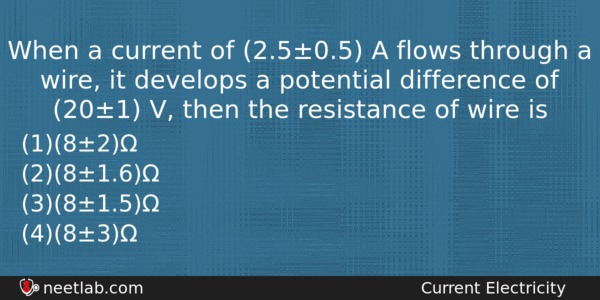| ⇦ | 
| ⇨ |
When a current of (2.5±0.5) A flows through a wire, it develops a potential difference of (20±1) V, then the resistance of wire is
Options
(a) (8±2)Ω
(b) (8±1.6)Ω
(c) (8±1.5)Ω
(d) (8±3)Ω
Correct Answer:
(8±2)Ω
Explanation:
No explanation available. Be the first to write the explanation for this question by commenting below.
Related Questions: - When the angle of incidence is 60° on the surface of a glass slab, it is found
- The ratio of minimum wavelengths of Lyman and Balmer series will be
- A bottle full of water in a space ship at 30⁰C is carried on the moon.
- When the disc rotates with uniform angulr velocity.Which of the following is not true?
- A electric dipole is placed at an angle of 30⁰ to a non-uniform electric field.
Topics: Current Electricity
(136)
Subject: Physics
(2479)
Important MCQs Based on Medical Entrance Examinations To Improve Your NEET Score
- When the angle of incidence is 60° on the surface of a glass slab, it is found
- The ratio of minimum wavelengths of Lyman and Balmer series will be
- A bottle full of water in a space ship at 30⁰C is carried on the moon.
- When the disc rotates with uniform angulr velocity.Which of the following is not true?
- A electric dipole is placed at an angle of 30⁰ to a non-uniform electric field.
Topics: Current Electricity (136)
Subject: Physics (2479)
Important MCQs Based on Medical Entrance Examinations To Improve Your NEET Score
18000+ students are using NEETLab to improve their score. What about you?
Solve Previous Year MCQs, Mock Tests, Topicwise Practice Tests, Identify Weak Topics, Formula Flash cards and much more is available in NEETLab Android App to improve your NEET score.
Share this page with your friends

R=V/I
R=20/2.5
R= 8 ohm
Now,
∆ R/R=∆ V/V+∆I/I
=1/20 +0.5/2.5
= 1/4
Therefore,
∆ R÷R=1÷4
∆ R=1÷4×R
∆R=1÷4×8
∆R=2
Therefore,
Resistance with error limits=R+ – ∆R
=(8+ – 2)ohm